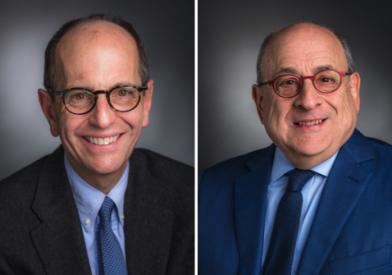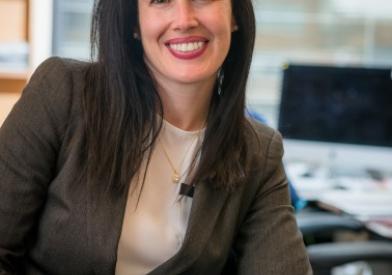A rhabdoid tumor is a rare childhood tumor that commonly starts in the kidneys and other soft tissues. It can sometimes grow in the brain, also known as atypical teratoid rhabdoid tumor (ATRT). A rhabdoid tumor that grows in the kidneys and soft tissues is called a malignant rhabdoid tumor (MRT).
- Malignant rhabdoid tumors occur most commonly in infants and toddlers; the average age of diagnosis is 15 months old.
- About 20 to 25 new cases of malignant rhabdoid tumors are diagnosed each year in the United States.
- Cells from malignant rhabdoid tumors in children can spread (metastasize) to other areas of the body.
Dana-Farber/Boston Children's Cancer and Blood Disorders Center is a world-leading center in the research and treatment of malignant rhabdoid tumors. Our Kidney Tumor Program is uncovering new opportunities to improve the care of children with malignant rhabdoid tumors.
Causes and Symptoms of Childhood Malignant Rhabdoid Tumor
There is no exact cause of rhabdoid tumors. Researchers have discovered that a gene called SMARCB1 (this gene also goes by the names INI1, SNF5, and BAF47) mutates in nearly all rhabdoid tumors, including malignant rhabdoid tumor (MRT) and atypical teratoid rhabdoid tumor (ATRT). Mutations in this gene can also sometimes occur in a patient's normal, non-tumor cells, increasing their risk of developing additional rhabdoid tumors.
Often the first sign that a child has a malignant rhabdoid tumor is discovering a lump or mass in the child's abdomen. Because malignant rhabdoid tumor occurs most frequently in infants, the child may not show any signs of pain or discomfort beyond fussiness. Some children with malignant rhabdoid tumors may have difficulty urinating or blood in the urine.
How We Diagnose Childhood Malignant Rhabdoid Tumor
Diagnostic procedures for malignant rhabdoid tumors detect the exact type of tumor and whether the cancer has spread. Your child's doctor will perform a complete medical and physical examination. They may also order advanced imaging studies and a biopsy to test for genetic mutation.
If we find a mutation, your child's doctor may recommend additional tests to see if the mutation is a germline mutation. A germline mutation is present throughout the body and could potentially pass within families. If the results are positive, your child's doctor may recommend testing you and other members of your family for the mutation, along with genetic counseling.
How We Treat Childhood Malignant Rhabdoid Tumor
Malignant rhabdoid tumor treatment involves a combination of therapies, including surgery, radiation, and chemotherapy. Because this tumor is rare and aggressive, there is no defined standard of care. We will tailor your child's treatment to their needs.
Treatment for malignant rhabdoid tumor may include:
- Surgery: In most cases, the first step in treating malignant rhabdoid tumors is surgery. Often a surgeon will try to remove the whole tumor at the time of biopsy. Depending on the tumor's size and location, the surgeon may remove only part of the kidney or the entire kidney.
-
Chemotherapy: After surgery, we may use a very aggressive course of chemotherapy, a group of drugs that interfere with the cancer cell's ability to grow or reproduce.
Different groups of chemotherapy drugs work in varied ways to fight cancer cells and shrink tumors. We typically use a combination of chemotherapy drugs, which may be given in a specific order depending on the cancer type. Children with malignant rhabdoid tumors receive chemotherapy as an injection into the muscle or fat tissue (intramuscularly) or directly into the bloodstream (intravenously).
While chemotherapy can be quite effective in treating certain cancers, the drugs cannot tell the difference between normal, healthy cells and cancer cells. Because of this, your child may experience adverse side effects during treatment. Understanding these side effects can help you, your child, and your care team prepare for, and in some cases, prevent these symptoms from occurring.
- Radiation therapy: Children more than six months old may receive radiation therapy as part of their treatment.
- Stem cell transplant: Malignant rhabdoid tumor treatment can be so intense that it affects the body's ability to produce normal blood and immune cells. For that reason, your child's doctor may recommend that your child undergo an autologous stem cell transplant. It involves temporarily removing some of a child's healthy blood cells and giving them very high doses of chemotherapy and, in some cases, radiation therapy to overwhelm and destroy the malignant rhabdoid tumor. We then give the child their stored, healthy blood cells to promote normal body and organ function once treatment is complete.
- Supportive care: Supportive care includes therapies to prevent and treat infections, side effects of treatments, and complications. The goal is to keep your child comfortable during treatment. It also is an integral part of preventing short- and long-term complications of the disease and treatment.
After treatment, we continue to care for your child and family through our pediatric cancer survivorship programs. When your child visits our survivorship clinic, our doctors and medical experts will manage disease complications, screen for early recurrence of cancer, and manage late effects of treatment. We also provide psychosocial, nutrition, and genetic counseling and access to support groups that include other childhood cancer survivors.



